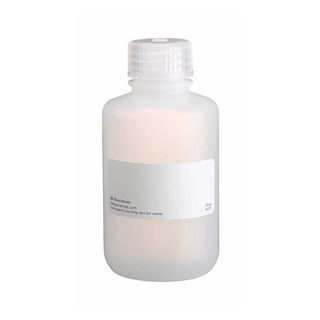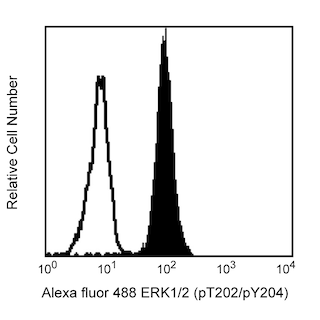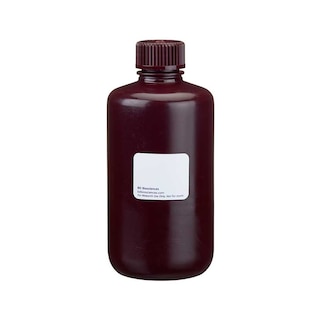Old Browser
This page has been recently translated and is available in French now.
Looks like you're visiting us from {countryName}.
Would you like to stay on the current country site or be switched to your country?





Analysis of p53 (acK382) in lymphocytes. Human peripheral blood mononuclear cells (PBMC) were either treated with 0.4 μM Trichostatin A (Sigma, Cat. No. T8552) plus 0.4 μM Adriamycin (Doxorubicin hydrochloride, Sigma, Cat. No. D1515) for 24 hours (shaded histogram) or untreated (open histogram). The cells were fixed (BD Cytofix™ buffer, Cat. No. 554655) for 10 minutes, then permeabilized (BD Phosflow™ Perm Buffer III, Cat. No. 558050) on ice for at least 30 minutes, and then stained with Alexa Fluor® 647 Mouse anti-p53 (acK382). Lymphocytes were selected by scatter profile. Flow cytometry was performed on a BD FACSArray™ bioanalyzer system. The specificity of mAb L82-51 was confirmed by western blot analysis using unconjugated antibody on lysates from control (left blot) and Trichostatin A-plus-Adriamycin-treated (right blot) PBMC. p53 (acK382) is identified as a band of 53 kDa in the treated cells.



BD™ Phosflow Alexa Fluor® 647 Mouse anti-p53 (acK382)

BD™ Phosflow Alexa Fluor® 647 Mouse anti-p53 (acK382)

Regulatory Status Legend
Any use of products other than the permitted use without the express written authorization of Becton, Dickinson and Company is strictly prohibited.
Preparation And Storage
Recommended Assay Procedures
This antibody conjugate is suitable for intracellular staining of human peripheral blood mononuclear cells (using BD Cytofix™ Fixation Buffer or BD Phosflow™ Fix Buffer I). Any of the three BD Phosflow™ permeabilization buffers may be used.
Product Notices
- This reagent has been pre-diluted for use at the recommended Volume per Test. We typically use 1 × 10^6 cells in a 100-µl experimental sample (a test).
- Caution: Sodium azide yields highly toxic hydrazoic acid under acidic conditions. Dilute azide compounds in running water before discarding to avoid accumulation of potentially explosive deposits in plumbing.
- Source of all serum proteins is from USDA inspected abattoirs located in the United States.
- Alexa Fluor® 647 fluorochrome emission is collected at the same instrument settings as for allophycocyanin (APC).
- The Alexa Fluor®, Pacific Blue™, and Cascade Blue® dye antibody conjugates in this product are sold under license from Molecular Probes, Inc. for research use only, excluding use in combination with microarrays, or as analyte specific reagents. The Alexa Fluor® dyes (except for Alexa Fluor® 430), Pacific Blue™ dye, and Cascade Blue® dye are covered by pending and issued patents.
- Alexa Fluor® is a registered trademark of Molecular Probes, Inc., Eugene, OR.
- For fluorochrome spectra and suitable instrument settings, please refer to our Multicolor Flow Cytometry web page at www.bdbiosciences.com/colors.
- Please refer to www.bdbiosciences.com/us/s/resources for technical protocols.
Companion Products





The p53 protein is critical to regulation of normal cell growth and proliferation and is a suppressor of tumor cell proliferation. Inactivation of p53 by a number of mechanisms, such as missense mutations or interaction with oncogenic viral or cellular proteins, can result in tumor progression. Mutations and/or allelic loss of the p53 gene are associated with a wide variety of human tumors. Known to have a role in transcriptional regulation, p53 suppresses various promoters containing TATA elements in an apparently sequence-independent fashion. p53 also binds to DNA in a sequence-specific manner via recognition of a 20-bp consensus-binding site. This interaction stimulates the expression of genes downstream of the p53 binding site. A number of genes that contain p53-binding sites have been identified, including MDM2, GADD45, and muscle creatine kinase. Post-translational acetylation of p53 enhances its DNA-binding activity. There are multiple factors that affect p53 acetylation, thereby modulating cellular proliferation and apoptosis.
The L82-51 monoclonal antibody recognizes acetylated lysine 382 (acK382) in the C-terminal region of p53.
Development References (8)
-
Hofmann TG, Moller A, Sirma H, et al. Regulation of p53 activity by its interaction with homeodomain-interacting protein kinase-2. Nat Cell Biol. 2002; 4:1-10. (Biology). View Reference
-
Ito A, Lai C-H, Zhao X, et al. p300/CBP-mediated p53 acetylation is commonly induced by p53-activating agents and inhibited by MDM2. EMBO J. 2001; 20(6):1331-1340. (Biology).
-
Nishino T, Wang C, Mochizuki-Kashio M, Osawa M, Nakauchi H, Iwama A. Ex vivo expansion of human hematopoietic stem cells by garcinol, a potent inhibitor of histone acetyltransferase. PLoS ONE. 2011; 6(9):e24298. (Clone-specific: Flow cytometry). View Reference
-
Pedeux R, Sengupta S, Shen JC, et al. ING2 regulates the onset of replicative senescence by induction of p300-dependent p53 acetylation. Mol Cell Biol. 2005; 25(15):6639-6648. (Biology).
-
Saito S, Goodarzi AA, Higashimoto Y, et al. ATM mediates phosphorylation at multiple p53 sites, including Ser46, in response to ionizing radiation. J Biol Chem. 2002; 277(15):12491-12494. (Biology).
-
Soliman MA, Riabowol K. After a decade of study-ING, a PHD for a versatile family of proteins. Trends Biochem Sci. 2007; 32(11):509-519. (Biology).
-
Solomon JM, Pasupuleti R, Xu L, et al. Inhibition of SIRT1 catalytic activity increases p53 acetylation but does not alter cell survival following DNA damage. Mol Cell Biol. 2006; 26(1):28-38. (Biology).
-
Vaziri H, Dessain SK, Eaton EN, et al. hSIR2[SIRT1] functions as an NAD-dependent p53 deacetylase . Cell. 2001; 107:149-159. (Biology).
Please refer to Support Documents for Quality Certificates
Global - Refer to manufacturer's instructions for use and related User Manuals and Technical data sheets before using this products as described
Comparisons, where applicable, are made against older BD Technology, manual methods or are general performance claims. Comparisons are not made against non-BD technologies, unless otherwise noted.
For Research Use Only. Not for use in diagnostic or therapeutic procedures.
Report a Site Issue
This form is intended to help us improve our website experience. For other support, please visit our Contact Us page.